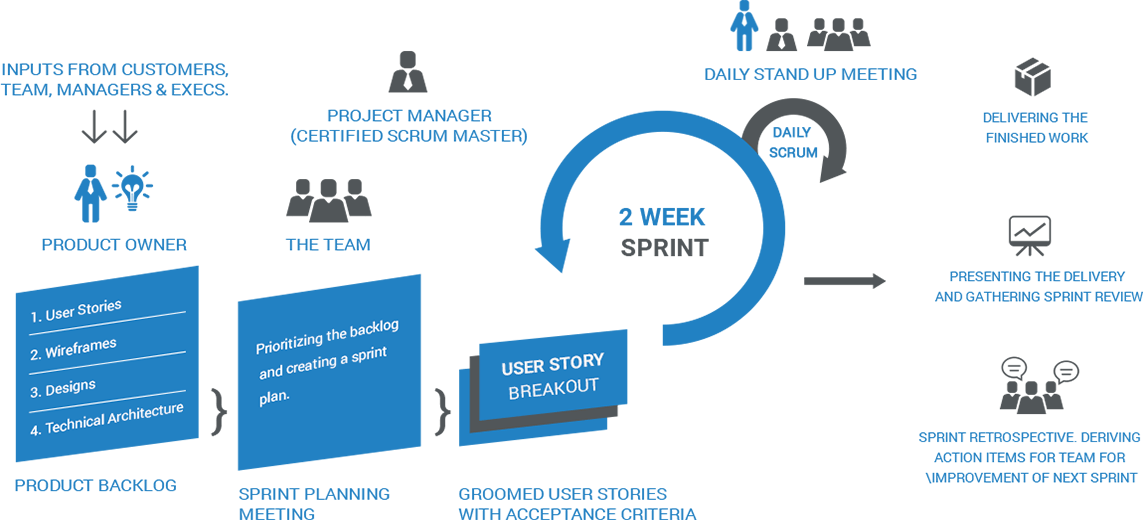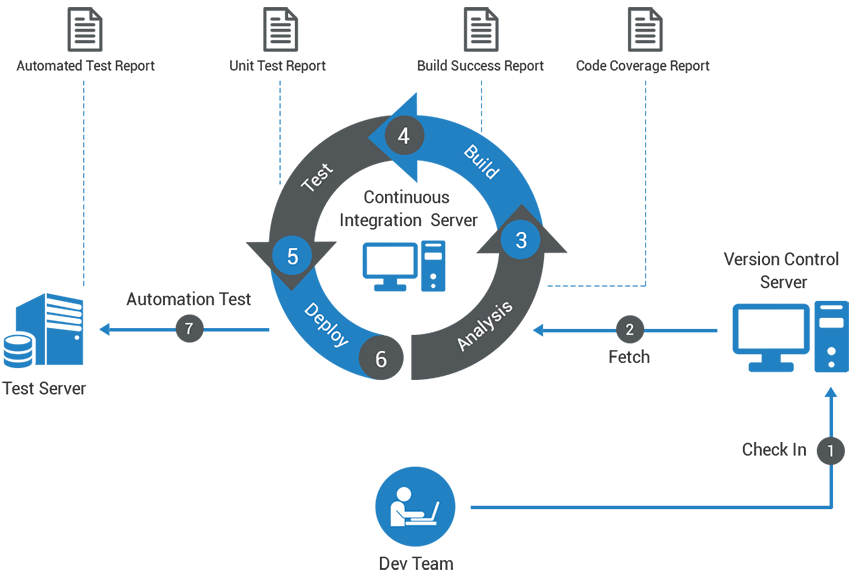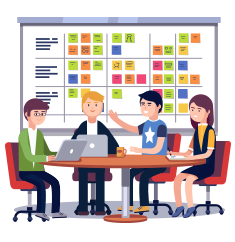Ultimate Guide to Development: Evolve Dynamic Web Applications Through Proven Practices
Trends and technologies of web development are evolving with each passing day. Every day, it becomes better and omnipotent. Embracing a variety of web-based frameworks and programming languages, programmers build exclusively customized websites that work coherently with other technologies such as mobility, cloud, IoT, augmented reality, virtual reality, wearables, and more.
You already have a profound insight into web application prototype and core development activities. Now, it’s time to execute the client’s requirements and project assumptions. Explore the various web application development and deployment processes. Also, have a look at the ultimate deliverables!
Agile Development Using SCRUM

Agile Methodology
Agile is a highly preferred software development methodology in the mature technology markets like Europe and USA. The methodology covers several incremental and iterative web application development practices. Amongst all, SCRUM is the most renowned and widely used agile practice for website development across the globe. Credencys has hands-on experience working with the Agile SCRUM processes.
To build robust applications, Agile supports continuous feedback gathering and iterations throughout the web development process. Experience an extreme flexibility as the method allows for ongoing planning, testing, integrations, and evolution of the software and project. Core benefit of adopting Agile is, it empowers the people to interact with each other and make effective decisions together rapidly.
Agile Traits for Effective Web Development
- Constant availability of customers is preferable throughout the web application development lifecycle.
- Leverage facility to change the requirements at any point in time.
- Prioritize the imperative features and functions first. Launch a valuable MVP by developing and deploying the important elements. It reduces the risk of investing in an unusable product development.
- A dedicated team of business analysts, project manager, designers, coders and quality analysts works on the project by establishing a high degree of synchronization and coordination with the stakeholders.
- It goes in-line with Time & Material model.
SCRUM Practices
Well-defined concepts and practices distinguish SCRUM from the other agile website development practices. It’s a subset of Agile and a lightweight framework for project development that is widely used by the reputed web application development company. SCRUM easily adjusts with frequently changing business requirements and creates pioneering websites that meet evolving organizational objectives.
How SCRUM Works?
Create Sprints
SCRUM divides the tasks into sprints. In agile methodology, sprints work as time-boxes. The timeline of the sprints is pre-decided. Ideally, web application development company needs to release the sprints after two weeks. It is not preferable to extend this timeline as it disturbs the overall development cycle.
Prioritize the Tasks
After analyzing user stories, developers create the list of required features and functions. They set the priority of all functionality and convert them into sprints. While creating sprints, programmers figure out the approx. time duration to develop each feature. Accordingly, they add the task to SCRUM backlogs.
Development and Deployment
As per the priority, engineers create a set of features and move ahead to execute them in order to build avant-garde web solutions. The website development cycle starts from writing the code, test the functionality, integrating third-party tools and technologies, to deploying a fully functional software on the server.
SCRUM Meeting
A meeting that involves developers, SCRUM master and stakeholders takes place every day in the morning for 15 minutes. All participants discuss the web development what they worked on the previous day, what they will work on that day, what are the roadblocks, and how to address barriers to website development process.
Feedback Gathering
When delivering the sprints, technical team offers a demo of developed features and functions to the stakeholders. Product owners review the sprints and share feedback. Though the feedback is related to current sprints, required modifications won’t be the part of existing sprints. Developers create fresh sprints of the changes and set them in backlog with the suitable remarks of adding and revising the items.
Sprint Retrospective
At the end of each sprint, SCRUM project management performs sprint retrospective. All members participate in the meeting including stakeholders and ScrumMaster. They discuss various aspects of the completed sprints and identify opportunities for improvement.
Benefits of Web Application Development Using SCRUM Practices
- Create more precise estimation within less time
- Improve the quality of deliverables
- Effectively address the required changes
- Control the project schedule and state
- Focused and self-organized team
- List out the requirements precisely in the form of stories
- Cross-functional teams work as a single unit
- Continuous improvements
- Open interaction with the client to decide priority of features
- Lower cost of development
Web Application Deployment Process at Credencys

Credencys’s web application deployment process involves various phases starting from check-in to the product to test automation. Every step plays a key role in completing the deployment cycle effectively.
Step 1 – Check-in: Development team check-in the version control system to set up a web application development environment.
Step 2 – Fetch: System fetches various details of a web application like architecture, programming language, framework, technologies, 3rd party integrations, web services, etc. and send the data further for in-depth analysis.
Step 3 – Analysis: Programmers analyze the website development environment, check the compatibility of coding and generate a code coverage report.
Step 4 – Build: If the structure and development environment of a web application seems suitable, then move ahead to configure the code and build a success report.
Step 5 – Test: It’s a very imperative part of the web application deployment process. Developers generate a unit test report that contains various data such as
- Define and execute acceptance criteria and test-cases
- Coding standard tests
- Performance and load testing
- APIs, UI/UX, functional and integration testing
- Bug reporting
- Test-case, bugs and performance reports
Step 6 – Deployment: Once the web application passes through all tests, next move is to deploy the code in a real-time environment.
Note: Activities from web application analysis to deployment are performed in the continuous integration server.
Step 7 – Automation Test: Once the code deployed in a suitable environment, the final web application passes through automated testing before going live. Engineers generate automated reports for each testing environment. Automated testing enables developers to deliver more reliable and authenticated websites that run smoothly and seamlessly.
Deliverables
Fully Functional Application
After completing a development and deployment cycle, the stakeholders receive a fully functional web application. Tested in an isolated environment, the website helps businesses in achieving expected organizational objectives. The deliverable product went through the several stages of development and deployment processes. In every phase, each of the features and functions is verified again and again to build error-free web solutions.
Test-cases and Quality Assurance Reports
Test cases are the cornerstones of quality assurance. Testers check out variables or conditions applied in the web application and determine whether it satisfies the client’s requirements properly and effectively.
Progress Reports
Following Agile SCRUM practices, the web application development company submits progress reports after every two weeks. During these 15 days, developers work on predefined features and functions. While delivering a progress report, engineers hand over the updated system along with the demonstration of new development. Thus, clients can test the system from their end, and operate the software smoothly without any technical assistance.
Source Code
Once a fully-fledged solution starts running seamlessly, developers deliver application source code to the stakeholders. It eliminates the chances of software duplication.
Documentation
While developing a website, coders have to create a document that explains all the features and functions in detail. It guides users about the activities performed by each element. Documentation works as a helping hand for the clients if they stuck somewhere while operating the system.
Why Choose Credencys as Your Web Application Development Partner?

Design Thinking
Team Credencys creates amazing UX and intelligent architecture following simplified processes. Experienced designers of the company make interactive and intuitive web applications that not only impress the customers but also encourage them to explore more about various offerings. Work closely with industry leaders who excel in creating solution-centric website designs that fuel your revenue cycle.
Open Communication
If you want to understand others, it is important to listen up them carefully. Credencys always listens to the customers, understand their expectations, convert their unique ideas into concepts, and innovate the revolutionary web applications. Following Agile SCRUM practices, the company stays connected with the clients throughout the development phase in order to collect information and feedback.
Continuous Development
Going beyond the obvious and getting into the depth allows Credencys teams to solve complex problems and make the customers succeed.
Verdict
Now just check it out! Your web application runs smoothly and effectively. Offering end-to-end web development services, Credencys believes in a win-win partnership. Being a leading web application development company, it helps clients in gaining the ultimate output.
Rather than working for the clients, the company believes to work with them and attains various milestones by adopting and implementing emerging technologies. Developing innovative web solutions, Credencys makes clients happy, satisfies their expectations and keeps them coming back for all IT needs.






Tags: